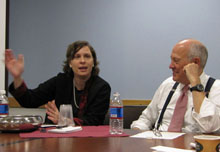Event
Transparency needed in innovation policy, says Crawford

November 2, 2009 — At the Shorenstein Center brown-bag lunch, Susan Crawford, Special Assistant to the President for Science, Technology and Innovation Policy, spoke about “Analog Policy to Digital Policy: Hope and Change.”
Crawford noted how Obama’s November 2007 policy agenda on technology and innovation recognized the “essential nature of high-speed communications infrastructure to economic growth, to connecting Americans to their government, to transforming the country in all kinds of ways.”
Crawford argued that too many subsidies are allocated to copper lines that support phones only, and what’s needed is a transition to fiber networks where “voice is just an application among many” and wireless communication is supported. The problem, Crawford says, is that “we are supporting the wrong thing for too much money, with the wrong people to do it,” and the biggest challenge will be “moving from an optimized network for voice to a generalized network for all services.”
Crawford explained the analog transition as “moving from dedicated silos…to the idea of multi-purpose platforms that take advantage of open standards…that make all kinds of innovative possibilities available,” much like a “sidewalk for interesting conversations.” However, the transition is difficult with a “brand-new technological world confronting an essentially unchanged set of government structures and understandings about how we wield power.”
Crawford supported transparency initiatives, such as President Obama’s memorandum on Transparency and Open Government (January 21, 2009), which was published in the Federal Register. “We only make progress when can we see what we’re doing,” and making government data visually accessible to Americans is powerful in the long term, Crawford said.
This article was written by Janell Sims and the photos taken by Leighton Walter Kille, both of the Shorenstein Center.